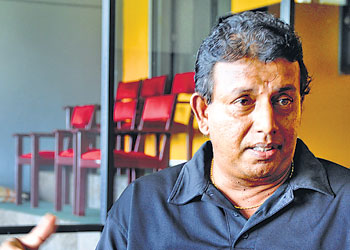Cricket’s very future and how it could survive is the talk of the town. Some prominent cricketers around the world has come out with their own remedial measures, but Sri Lanka’s most respected umpire Asoka de Silva who is also the island nation’s only representative in the ICC elite panel does think the apple cart should not be rocked too much.
 |
| Asoka De Silva |
Explaining his views on the present day structure of cricket in an exclusive interview with the Sunday Times the former Sri Lanka Test leg spinner said “Test cricket is the ultimate. I don’t think any top cricketer in the world will want to drive away from Test cricket. Though people talk, I can not see Test cricket dying. If you have played Test cricket you know how you fell for it. So much so the more you play the more you want it. It tests your entire ability - stamina, endurance, your knowledge of the game, how you interpret your thoughts into action over a long period is clearly depicted in Test cricket.”
However de Silva agreed that the time factor involved with Test cricket in the present context has posed some problems. “In these busy times where time is gold, for people to come and watch Test cricket during day time over five days creates a problem. But, still people do watch Test cricket. In countries like England, Australia, South Africa and even India people do go to watch Test cricket.
The answer may be the introduction of day-night Test cricket, provided they invent the correct ball. For instance the white ball that is used for ODIs lasts a maximum for 25-27 overs. Thereafter it gets really dirty and loses its colour. So if you want to play day-night Tests you would have to invent a ball that would last the conventional 80 overs or make drastic changes to the playing conditions. Under these circumstances I cannot see day-night Test cricket overtaking the normal game immediately.”
The ICC elite panel umpire de Silva sees a conflict in the 20-20 and the 50 over versions. He said “I see a conflict in these two versions of the game. In some cases there are instances where they play up to seven One-day internationals. It’s all hunky-dory if the games goes on with a balance, but if a side wins the first four games the balance three matches are played to almost empty stands. If it is a large country like India where you can play the seven games in seven geographically different locations it is okay. But, any other place, I do not think it is advisable. What I see is that ODIs should be confined to three generally, and in exceptional cases a maximum of five games. Then to balance it off if countries can arrange tours of 3 Tests, Three ODIs and 3 T20s people will still be at the stands to watch them. I feel at present definitely the T20 version is more popular than the 50 over version. Even most of the top players want to play in T20 matches. In a cricketing sense the T20 version does not tax the cricketers as much as the other two versions.”
Asoka de Silva also feels that in 50 overs, the game tends to drag on between the 20th and the 40th overs. Even if the side is going to score over 300 runs the batting side tends to slow down during the middle overs. “This is the point where the mundane cricket fan tends to lose focus.” De Silva pointed out. “The difference between Test cricket and limited over cricket is batting and people want to see runs being scored at a faster rate in an ODI, if the authorities can find some solution to this anomaly in 50 over cricket it gives the game a new perspective” de Silva said in conclusion. |

